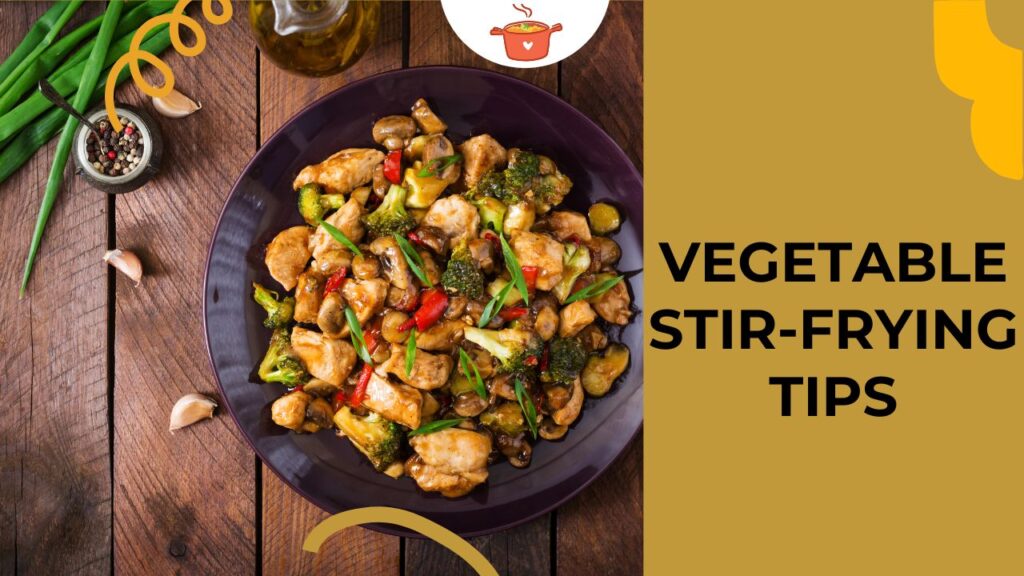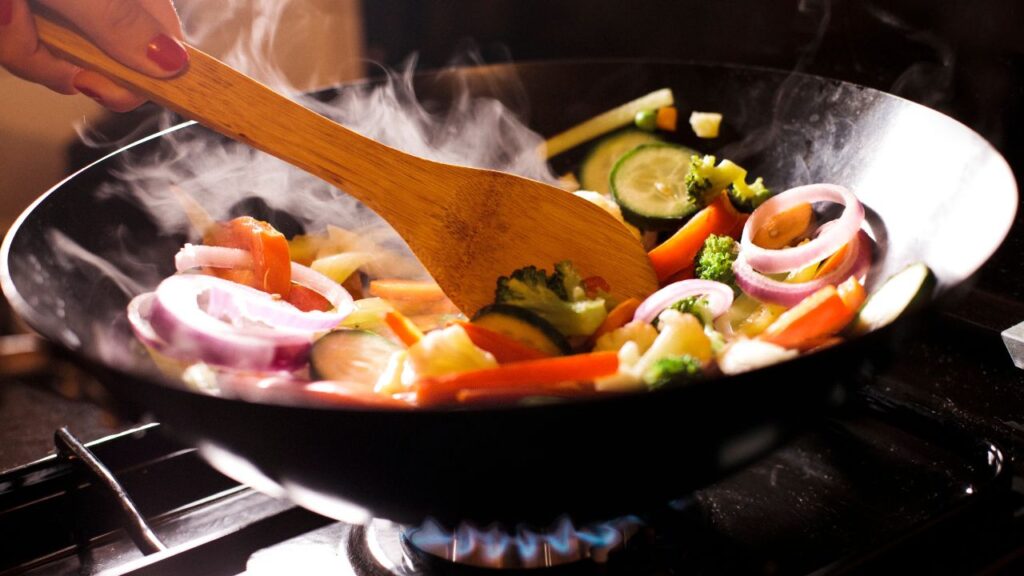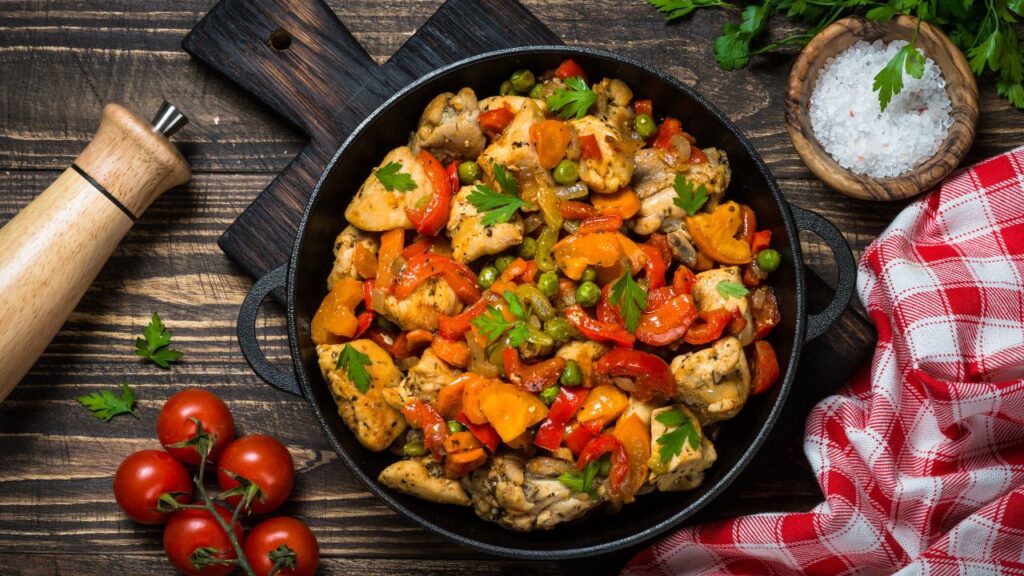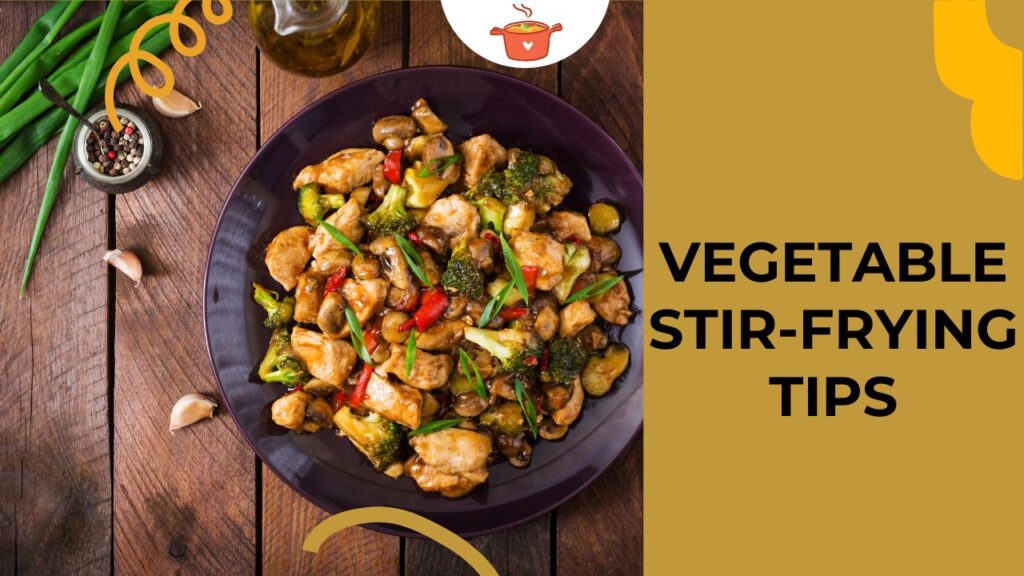
Have you ever wondered how to create a delicious, colorful meal in just minutes? Simple vegetable stir-frying tips can transform your kitchen routine, making it easier than ever to whip up healthy and flavorful dishes. Whether you’re a beginner or a seasoned cook, mastering stir-frying techniques can add variety and excitement to your meals. Let’s explore the art of vegetable stir-frying and uncover tips that will make your dishes shine.
Contents
- 1 Understanding Vegetable Stir-Frying
- 2 Essential Tips for Perfect Vegetable Stir-Frying
- 3 Step-by-Step Guide to Stir-Frying Vegetables
- 4 Common Mistakes to Avoid in Stir-Frying
- 5 Enhancing Your Stir-Fry with Additional Ingredients
- 6 Nutritional Benefits of Vegetable Stir-Frying
- 7 Equipment and Tools for Successful Stir-Frying
- 8 Quick and Simple Vegetable Stir-Fry Recipes
- 9 Tips for Serving and Storing Stir-Fried Vegetables
- 10 Frequently Asked Questions (FAQs)
- 11 Conclusion
Understanding Vegetable Stir-Frying
Definition
Stir-frying is a quick cooking method that originated in Chinese cuisine. It involves cooking vegetables (and sometimes proteins) over high heat in a small amount of oil while continuously stirring. This technique ensures that ingredients cook evenly and retain their vibrant colors and crisp textures.
Benefits
Stir-frying offers numerous advantages:
- Quick Cooking Time: Meals can be prepared in under 30 minutes.
- Nutrient Preservation: The high heat and short cooking time help retain vitamins and minerals.
- Versatility: You can use a wide variety of vegetables and flavors to create endless combinations.
- Minimal Cleanup: Using just one pan reduces the number of dishes to wash.
Common Tools
To get started with stir-frying, you’ll need a few essential tools:
- Wok or Skillet: A wok is traditional and excellent for high-heat cooking, but a heavy-bottomed skillet works well too.
- Spatula: A sturdy spatula for tossing and stirring ingredients.
- Cutting Board and Knife: For preparing vegetables and other ingredients.
Essential Tips for Perfect Vegetable Stir-Frying
a. Planning and Preparation
Ingredient Selection
Choosing fresh, high-quality vegetables is key to a delicious stir-fry. Opt for a variety of colors and textures to make your dish visually appealing and nutritionally balanced. Common choices include bell peppers, broccoli, snap peas, carrots, and mushrooms.
Meal Planning
Planning your stir-fry ahead of time can streamline the cooking process. Decide which vegetables and proteins you want to include and ensure you have all the necessary ingredients on hand. This preparation helps prevent last-minute rushes and ensures a smooth cooking experience.
Prep Work
Prepping ingredients in advance, known as “mise en place,” is crucial for stir-frying. Chop vegetables into uniform sizes to ensure even cooking. Measure out sauces and seasonings beforehand to keep everything organized and within reach during cooking.
b. Choosing the Right Vegetables
Best Vegetables for Stir-Frying
Certain vegetables perform exceptionally well in stir-fries:
- Bell Peppers: Add sweetness and crunch.
- Broccoli: Provides a hearty texture and absorbs flavors beautifully.
- Snap Peas: Offer a crisp bite and vibrant color.
- Carrots: Bring sweetness and a slight crunch.
- Mushrooms: Add umami and depth to the dish.
Seasonal Vegetables
Incorporating seasonal produce can enhance the flavor and nutrition of your stir-fry. Seasonal vegetables are often fresher and more affordable, allowing you to create dishes that are both delicious and budget-friendly.
Combining Textures and Flavors
Balancing crunchy and tender vegetables creates a harmonious dish. For example, pairing crisp snap peas with tender broccoli ensures that each bite offers a delightful mix of textures. Additionally, combining sweet, savory, and spicy flavors can elevate your stir-fry to new heights.
c. Selecting the Right Oil
High-Heat Oils
Choosing an oil with a high smoke point is essential for stir-frying. Suitable options include:
- Peanut Oil: Neutral flavor and high smoke point.
- Canola Oil: Light taste and good for high-heat cooking.
- Grapeseed Oil: Mild flavor and excellent for stir-frying.
Flavorful Oils
Incorporating oils that add flavor can enhance your dish. Sesame oil is a popular choice for its rich, nutty taste. Use it sparingly to avoid overpowering the other flavors.
Avoiding Low-Smoke Point Oils
Certain oils, like olive oil, have lower smoke points and can burn easily at high temperatures, leading to bitter flavors. It’s best to avoid these oils for stir-frying and reserve them for dressings or low-heat applications.
d. Mastering Heat Management
Preheating the Pan
Properly heating your wok or skillet before adding oil is crucial. A hot pan ensures that ingredients sear quickly, locking in flavors and preventing sticking. To test the heat, sprinkle a few drops of water into the pan; if they sizzle and evaporate immediately, the pan is ready.
Maintaining High Heat
Stir-frying requires consistently high heat to cook ingredients quickly and retain their crispness. Keep the heat on medium-high to high throughout the cooking process, adjusting as needed to prevent burning.
Avoiding Overcrowding
Overcrowding the pan can lead to steaming instead of stir-frying, resulting in soggy vegetables. Cook in batches if necessary, ensuring each ingredient has enough space to cook evenly and develop a nice sear.

e. Flavoring and Seasoning
Aromatics
Aromatics like garlic, ginger, and onions form the flavorful base of your stir-fry. Sautéing these ingredients first releases their essential oils, adding depth to the dish.
Sauces and Seasonings
Creating a simple stir-fry sauce can elevate your vegetables. Common ingredients include:
- Soy Sauce: Adds saltiness and umami.
- Hoisin Sauce: Provides sweetness and thickness.
- Oyster Sauce: Enhances flavor with its rich, savory profile.
Balancing Flavors
Achieving a balance of salty, sweet, sour, and spicy elements creates a well-rounded dish. Adjust seasonings to taste, adding ingredients like a splash of rice vinegar for acidity or a dash of chili flakes for heat.
Step-by-Step Guide to Stir-Frying Vegetables
a. Preparing the Ingredients
Uniform Cutting
Cutting vegetables into similar sizes ensures even cooking. For example, slice bell peppers into thin strips and chop broccoli into bite-sized florets. Uniform pieces cook at the same rate, preventing some vegetables from becoming overcooked while others remain underdone.
Marinating Proteins (if applicable)
If you’re adding proteins like tofu, chicken, or beef, marinate them briefly to infuse flavor. A simple marinade of soy sauce, garlic, and a touch of sesame oil works well. Let the proteins sit for at least 15 minutes before cooking.
b. Cooking Techniques
Searing Proteins (if included)
Start by searing proteins in the hot pan until they’re browned on all sides. This step adds depth and flavor to the dish. Remove the proteins from the pan and set them aside before cooking the vegetables.
Sequential Cooking
Add vegetables to the pan based on their cooking times. Begin with those that take longer to soften, such as carrots and broccoli, followed by quicker-cooking vegetables like snap peas and bell peppers. This ensures that all ingredients reach the desired level of tenderness.
Stirring and Tossing
Constantly stir and toss the vegetables to promote even cooking and prevent sticking. Use a spatula to lift and fold the ingredients, ensuring each piece gets exposed to the heat.
c. Final Touches
Adding Fresh Herbs
Incorporate fresh herbs like cilantro or green onions at the end of cooking for a burst of freshness. This adds a vibrant flavor contrast to the rich, savory elements of the stir-fry.
Adjusting Seasonings
Before serving, taste your stir-fry and adjust the seasoning as needed. Add more soy sauce for saltiness, a bit of honey for sweetness, or a squeeze of lime for acidity to perfect the balance of flavors.
Common Mistakes to Avoid in Stir-Frying
a. Using Too Much Oil
Proper Oil Quantity
Using just enough oil to coat the pan prevents the dish from becoming greasy. Typically, 1-2 tablespoons of oil are sufficient for most stir-fries. Excess oil can dilute flavors and make the vegetables soggy.
Techniques to Reduce Oil Usage
Measure your oil carefully and consider using a brush to evenly distribute a thin layer. Alternatively, use non-stick pans that require less oil for cooking.
b. Overcooking or Undercooking Vegetables
Cooking Times
Each vegetable has a different cooking time. Harder vegetables like carrots and broccoli take longer to cook, while softer ones like bell peppers and snap peas cook quickly. Adding ingredients in the correct order ensures all vegetables are cooked perfectly.
Texture Control
Aim for crisp-tender vegetables that retain their natural crunch. Overcooking can make them mushy, while undercooking can result in a raw taste. Use a timer and keep a close eye on your stir-fry to maintain the ideal texture.
c. Not Preheating the Pan
Temperature Importance
A properly preheated pan ensures that ingredients sear quickly, locking in flavors and preventing sticking. If the pan isn’t hot enough, vegetables will release moisture and steam instead of stir-frying.
Signs of a Hot Pan
To check if your pan is hot enough, sprinkle a few drops of water onto the surface. If they sizzle and evaporate immediately, the pan is ready for cooking.
Enhancing Your Stir-Fry with Additional Ingredients
a. Adding Proteins
Vegetarian Options
For plant-based stir-fries, incorporate proteins like tofu, tempeh, or seitan. These options absorb flavors well and add substance to your meal. Press and marinate tofu before cooking to enhance its texture and taste.
Meat Options
Adding chicken, beef, shrimp, or pork can make your stir-fry more filling and add rich flavors. Ensure that meats are cooked thoroughly before adding vegetables to the pan.
Cooking Proteins Separately
If necessary, cook proteins separately to avoid overcrowding the pan. This allows each component to cook evenly and prevents the stir-fry from becoming greasy.
b. Incorporating Grains and Noodles
Rice
Adding cooked rice can turn your stir-fry into a complete meal. Consider making fried rice by adding pre-cooked rice directly to the pan, allowing it to absorb the flavors of the stir-fry.
Noodles
Integrate noodles like soba, udon, or rice noodles for a more substantial dish. You can cook noodles directly in the stir-fry sauce, allowing them to soak up the flavors as they cook.
Cooking Together
Cooking grains or noodles together with vegetables and sauces can create a harmonious blend of flavors. Ensure there’s enough liquid in the pan to prevent sticking and allow the grains or noodles to cook evenly.
c. Using Nuts and Seeds
Adding Crunch
Incorporate nuts like cashews or peanuts, or sprinkle sesame seeds over your stir-fry to add a delightful crunch. These ingredients also provide healthy fats and additional nutrients.
Flavor Enhancement
Nuts and seeds can enhance the overall flavor profile of your dish. Toasting them lightly before adding can bring out their natural nuttiness and add depth to your stir-fry.

Nutritional Benefits of Vegetable Stir-Frying
Preservation of Nutrients
Stir-frying is a nutrient-preserving cooking method. The quick cooking time and high heat help retain vitamins and minerals that can be lost through longer cooking processes.
Balanced Meals
Combining vegetables with proteins and grains creates a well-rounded meal that provides a variety of essential nutrients. This balance supports overall health and keeps you satisfied longer.
Healthy Fats
Using healthy oils in moderation, such as olive oil or sesame oil, adds beneficial fats to your diet. These fats are essential for nutrient absorption and provide energy.
Equipment and Tools for Successful Stir-Frying
a. Choosing the Right Pan
Wok vs. Skillet
- Wok: Traditional for stir-frying, offers excellent heat distribution and ample cooking space. Its sloped sides make tossing ingredients easier.
- Skillet: A heavy-bottomed skillet is a versatile alternative if you don’t have a wok. It can still achieve high-heat cooking and even searing.
Non-Stick vs. Carbon Steel
- Non-Stick: Easier to clean and require less oil, but may not handle high heat as well as other materials.
- Carbon Steel: Preferred by professional chefs for its durability and superior heat conduction. It requires seasoning to maintain its non-stick surface.
b. Essential Utensils
Spatulas and Spoons
A sturdy spatula is essential for stirring and tossing ingredients. Wooden or silicone spatulas are ideal as they won’t scratch your cookware.
Cutting Boards and Knives
Quality cutting tools ensure efficient prep work. A sharp knife and a reliable cutting board make chopping vegetables faster and safer.
Other Tools
Additional tools like measuring spoons, ladles, and storage containers help keep your kitchen organized and your cooking process smooth.
c. Maintenance and Care
Cleaning Your Wok or Skillet
Proper cleaning extends the life of your cookware. For carbon steel woks, avoid using soap and instead scrub with hot water and a brush, then dry thoroughly and lightly oil to prevent rust.
Proper Storage
Store your pans in a dry place to prevent moisture buildup. If using a wok, keep it dry and lightly oiled to maintain its seasoning.
Quick and Simple Vegetable Stir-Fry Recipes
Basic Vegetable Stir-Fry
A straightforward recipe with common vegetables and a simple soy-based sauce.
Ingredients:
- 1 tablespoon vegetable oil
- 2 cloves garlic, minced
- 1-inch piece ginger, grated
- 2 cups mixed vegetables (bell peppers, broccoli, snap peas)
- 2 tablespoons soy sauce
- 1 tablespoon oyster sauce (optional)
- 1 teaspoon cornstarch mixed with 2 tablespoons water
Instructions:
- Heat oil in a wok over high heat.
- Add garlic and ginger, stir-fry for 30 seconds.
- Add vegetables, stir-fry for 5-7 minutes until crisp-tender.
- Pour in soy sauce and oyster sauce, stir well.
- Add cornstarch mixture to thicken the sauce, cook for another minute.
- Serve hot with rice or noodles.
Garlic Ginger Stir-Fry
A flavorful variation using fresh garlic and ginger for a robust taste.
Ingredients:
- 1 tablespoon sesame oil
- 3 cloves garlic, minced
- 1-inch piece ginger, julienned
- 3 cups assorted vegetables (carrots, bell peppers, zucchini)
- 2 tablespoons soy sauce
- 1 tablespoon hoisin sauce
- 1 teaspoon chili flakes (optional)
Instructions:
- Heat sesame oil in a wok over medium-high heat.
- Add garlic and ginger, stir-fry until fragrant.
- Add vegetables, cook for 5-6 minutes until tender.
- Mix in soy sauce, hoisin sauce, and chili flakes.
- Stir well and cook for another 2 minutes.
- Garnish with green onions and serve.
Spicy Szechuan Stir-Fry
Adding heat with Szechuan peppercorns and chili paste for an authentic kick.
Ingredients:
- 2 tablespoons peanut oil
- 2 cloves garlic, minced
- 1 tablespoon Szechuan peppercorns, crushed
- 1 tablespoon chili paste
- 2 cups mixed vegetables (bok choy, mushrooms, bell peppers)
- 2 tablespoons soy sauce
- 1 teaspoon rice vinegar
Instructions:
- Heat peanut oil in a wok over high heat.
- Add garlic and Szechuan peppercorns, stir-fry for 30 seconds.
- Add chili paste, cook for another minute.
- Toss in vegetables, stir-fry until crisp-tender.
- Pour in soy sauce and rice vinegar, mix well.
- Serve with steamed rice for a spicy delight.
Honey Soy Vegetable Stir-Fry
A sweet and savory combination using honey and soy sauce for a balanced flavor.
Ingredients:
- 1 tablespoon vegetable oil
- 2 cloves garlic, minced
- 1 tablespoon fresh ginger, grated
- 3 cups vegetables (snap peas, carrots, bell peppers)
- 3 tablespoons soy sauce
- 2 tablespoons honey
- 1 teaspoon sesame oil
Instructions:
- Heat vegetable oil in a skillet over medium-high heat.
- Add garlic and ginger, sauté until fragrant.
- Add vegetables, stir-fry for 5-7 minutes.
- In a small bowl, mix soy sauce and honey.
- Pour the sauce over vegetables, stir to coat evenly.
- Drizzle with sesame oil before serving.
Lemon Vegetable Stir-Fry
Brightening the dish with a splash of lemon juice for a refreshing twist.
Ingredients:
- 1 tablespoon olive oil
- 2 cloves garlic, minced
- 1 lemon, juiced
- 2 cups mixed vegetables (broccoli, bell peppers, snow peas)
- 2 tablespoons soy sauce
- 1 teaspoon honey
- Zest of 1 lemon
Instructions:
- Heat olive oil in a wok over medium-high heat.
- Add garlic, stir-fry for 30 seconds.
- Add vegetables, cook for 5-6 minutes until tender-crisp.
- In a small bowl, combine lemon juice, soy sauce, and honey.
- Pour the mixture over vegetables, stir well.
- Sprinkle lemon zest before serving for an extra zing.
Tips for Serving and Storing Stir-Fried Vegetables
Serving Suggestions
Presentation can enhance the dining experience. Serve your stir-fry over a bed of steamed rice or alongside noodles for a complete meal. Garnish with fresh herbs, sesame seeds, or a drizzle of sesame oil to add visual appeal and extra flavor.
Storage Tips
Store leftover stir-fried vegetables in an airtight container in the refrigerator for up to 3 days. To maintain freshness, let the stir-fry cool completely before sealing and refrigerating.
Reheating Methods
Reheat stir-fried vegetables on the stovetop over medium heat, stirring occasionally to ensure even heating. Alternatively, microwave individual portions in a microwave-safe container, covering with a damp paper towel to retain moisture.
Frequently Asked Questions (FAQs)
1. How to prevent vegetables from becoming soggy when stir-frying?
To avoid soggy vegetables, ensure your pan is hot enough before adding ingredients and avoid overcrowding the pan. Cook vegetables in batches if necessary, allowing excess moisture to evaporate quickly.
2. What are the best vegetables for stir-frying?
Vegetables that hold up well to high heat and quick cooking are ideal for stir-frying. Popular choices include bell peppers, broccoli, snap peas, carrots, mushrooms, and bok choy.
3. How to achieve the perfect stir-fry texture?
Aim for crisp-tender vegetables by cooking them quickly over high heat and not overcooking. Cutting vegetables into uniform sizes and adding them in the correct order also helps maintain the desired texture.
4. What oil is best for high-heat stir-frying?
Oils with high smoke points are best for stir-frying, such as peanut oil, canola oil, and grapeseed oil. These oils can withstand the high temperatures needed without burning or smoking excessively.
5. How to make a simple stir-fry sauce at home?
A basic stir-fry sauce can be made by combining soy sauce, a sweetener like honey or sugar, and a thickener like cornstarch mixed with water. Add ingredients like garlic, ginger, or chili paste for extra flavor.
6. Can you stir-fry vegetables without a wok?
Yes, a heavy-bottomed skillet or a large frying pan can be used as alternatives to a wok. Ensure the pan is large enough to accommodate all ingredients without overcrowding.
7. What are some quick vegetable stir-fry recipes?
Quick recipes include basic vegetable stir-fry, garlic ginger stir-fry, spicy Szechuan stir-fry, honey soy vegetable stir-fry, and lemon vegetable stir-fry. These dishes can be prepared in under 30 minutes.
8. How to clean a wok after stir-frying?
For carbon steel woks, avoid soap. Instead, scrub with hot water and a brush, then dry thoroughly and lightly oil to prevent rust. For non-stick woks, use warm soapy water and a soft sponge to clean gently.
Conclusion
Mastering simple vegetable stir-frying tips can elevate your home cooking, allowing you to create vibrant, nutritious, and delicious meals with ease. By understanding the fundamentals of ingredient selection, heat management, and flavor balancing, you can consistently produce stir-fries that are both satisfying and healthy. Whether you’re looking to whip up a quick weeknight dinner or impress guests with your culinary skills, stir-frying offers a versatile and efficient solution. So, grab your wok or skillet, gather your favorite vegetables, and start experimenting with these tips to bring exciting flavors to your table. Happy stir-frying!

